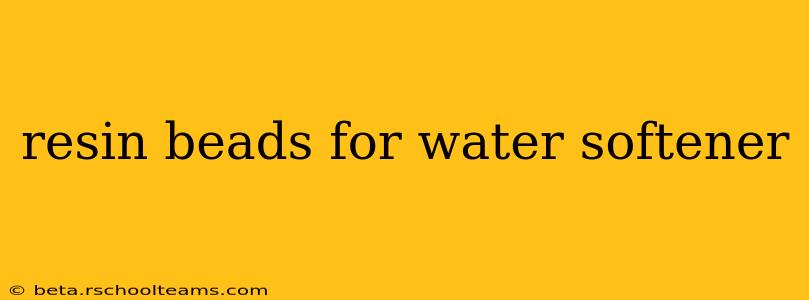Water softeners are essential for many households, removing hardness minerals like calcium and magnesium that can clog pipes, damage appliances, and leave unsightly spots on dishes. At the heart of every water softener lies a crucial component: the resin beads. These tiny, but mighty, beads are responsible for the softening process, and understanding their role is key to maintaining a properly functioning system. This guide will delve into the world of resin beads, answering common questions and providing valuable insights for homeowners and water treatment professionals alike.
What are Resin Beads in a Water Softener?
Resin beads are small, spherical particles made from a synthetic polymer resin. These beads possess negatively charged functional groups, typically sulfonic acid groups, that attract and bind positively charged calcium and magnesium ions present in hard water. This ion exchange process is the core of water softening. The resin beads don't simply filter out the minerals; they actively trade them for sodium ions, resulting in softer water.
How Do Resin Beads Work in a Water Softener?
The process is remarkably efficient. As hard water flows through the resin bed, the calcium and magnesium ions are exchanged for sodium ions already present on the resin beads. This continues until the resin beads become saturated with calcium and magnesium, at which point they need regeneration. Regeneration involves flushing the resin bed with a concentrated solution of sodium chloride (table salt), reversing the ion exchange process and replenishing the sodium ions. This ensures the resin beads are ready to continue softening water.
What are the Different Types of Resin Beads?
While the fundamental principle remains consistent, different types of resin beads exist, each with its own properties and suitability for various applications. These differences often relate to the size, strength, and ion exchange capacity of the beads. Some key distinctions include:
- Gel beads: These are the most common type, offering a good balance of performance and cost.
- Macroporous beads: These beads possess a larger pore size, allowing for better flow rates and regeneration efficiency, especially in waters with high levels of organic matter.
How Long Do Resin Beads Last?
The lifespan of resin beads depends on several factors, including water quality, frequency of use, and proper maintenance. Typically, resin beads can last for 10-15 years, but this can vary significantly. Regular monitoring and appropriate regeneration are essential for extending their lifespan. Signs of potential resin bead failure might include a noticeable decrease in softening capacity or an increase in water hardness despite proper regeneration.
What is the difference between gel and macroporous resin?
Gel resin beads are more common and generally more cost-effective. They’re suitable for most applications. Macroporous resin beads, on the other hand, are better suited for water that contains high levels of organic matter or iron. Their larger pore size prevents clogging and allows for better regeneration.
How often should I regenerate my water softener?
Regeneration frequency depends on your water usage and the capacity of your softener. Most softeners have a timer or meter that determines when regeneration is necessary. Generally, regeneration is scheduled weekly or bi-weekly.
How can I tell if my resin beads need replacing?
If you notice a persistent hardness in your water despite regular regeneration, or if the amount of salt used for regeneration is drastically increasing, it may be a sign that your resin beads need replacing. A water test can confirm the level of hardness and help determine if the issue stems from the resin.
Can I clean my resin beads?
You cannot directly clean the resin beads. The regeneration process is designed to cleanse them. Physical cleaning would likely damage them. Instead, focus on proper maintenance and timely regeneration.
By understanding the role of resin beads in water softeners, homeowners can better maintain their systems and ensure they are receiving the benefits of soft water. Remember, regular maintenance, including appropriate salt replenishment and scheduled regeneration, is key to preserving the life and efficiency of these crucial components.
